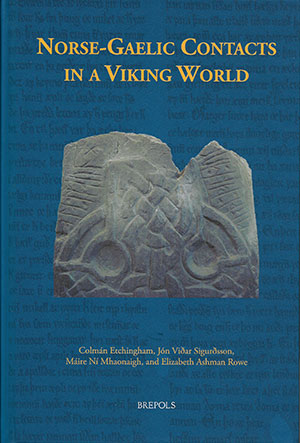NORSE–GAELIC CONTACTS IN A VIKING WORLD
Published in Book Reviews, Book Reviews, Issue 6 (November/December 2019), Volume 27Colmán Etchingham, Jón Viðar Sigurðsson, Máire Ní Mhaonaigh and Elizabeth Ashman Rowe (eds)
Brepols
€65
ISBN 9782503579023
Reviewed by Seán Duffy
Seán Duffy is Professor of Medieval Irish and Insular History at Trinity College Dublin.
 This is a book by academics for academics. Also, the indefinite article in the title matters. If we take the Viking Age to be that period of northern European history stretching from the earliest Viking raid (on Lindisfarne in AD 793) to, at a push, the death near Downpatrick of the Norse king, Magnus Barelegs, in 1103, it is not—surprising as it may seem—the period directly under study in this volume. Rather, it presents four separate studies of four separate literary texts or collections dating from the thirteenth century, though all shed light on the Viking Age to a greater or lesser extent.
This is a book by academics for academics. Also, the indefinite article in the title matters. If we take the Viking Age to be that period of northern European history stretching from the earliest Viking raid (on Lindisfarne in AD 793) to, at a push, the death near Downpatrick of the Norse king, Magnus Barelegs, in 1103, it is not—surprising as it may seem—the period directly under study in this volume. Rather, it presents four separate studies of four separate literary texts or collections dating from the thirteenth century, though all shed light on the Viking Age to a greater or lesser extent.
The first is Konungs skuggsjá (‘The King’s Mirror’), a Norwegian work dating from the mid-thirteenth century and of the same genre as Machiavelli’s The Prince, being intended to instruct rulers on how to rule. Konungs skuggsjá was probably written by someone attached to the Norwegian court, perhaps meant for the sons of King Hákon IV (d. 1263), but contains a seam of material that refers to Ireland and, more specifically, to strange places and phenomena in Ireland—mountain springs on Slieve Bloom that cause the white hair of humans and animals to turn black; a monastic island on Lough Ree where nothing female, human or animal, can survive; an anchor preserved at Clonmacnoise that had fallen from a flying ship; and more besides.
Inclusion of these ‘wonders of Ireland’ shows that an interest in Ireland existed in thirteenth-century Norway, and the question arises as to why it might have seemed important to include this material and where in the Gaelic world it had originated. It so happens that King Hákon IV of Norway died in Orkney in 1263 on a naval expedition during which emissaries from the Irish had asked him to come to Ireland and seize its kingship from the English. The authors speculate that this might have been the context for the interest in Ireland shown in Konungs skuggsjá, though it’s hard to see a direct link and, in general, the authors’ tendency to shoehorn texts and activity into the time-frame of Hákon’s expedition is a bit forced. The book’s other main thesis, that this and other Irish material in Icelandic sources may have been composed or gathered in the Isle of Man, is more than plausible but perhaps blinds the authors to other possibilities. The Gaelic world of the title, for instance, largely excludes mainland Gaelic Scotland, but the book’s focus on Ireland, Man, Iceland and Norway—what the authors call, in a phrase that does not trip lightly off the tongue, ‘the Norwegian Insular Viking Zone’—ignores the fact that Scotland lies culturally at the fulcrum of such a world, as it does geographically.
Where the Isle of Man does feature centrally is in the poem Baile Suthach Sith Emhna (‘The Otherworld of Eamhain is a Fertile Settlement’), which comes in for similarly exhaustive treatment. This is a poem in the strict dán díreach style of Irish verse. Thousands of such works survive in a variety of metrical patterns all the way to the collapse of the Gaelic order in the seventeenth century and this may well be the oldest surviving such poem. And yet it is written, in Irish, in praise not of an Irishman but of a Manxman. It is a praise-poem for Ragnall, king of Man and the Isles from 1187 to 1226, and the volume contains a detailed study of the poem and its context, the most thorough examination to which it has hitherto been exposed.
The last two studies contain some of the most exciting work in the volume. The first of these examines the account of the Battle of Clontarf found in Icelandic sources, including Njáls saga, and the idea that this material might have originated in a now lost Brjáns saga, a Norse saga about Brian Boru. The authors largely agree with the findings of the late Donnchadh Ó Corráin on the matter, although, while he suggested composition in Dublin c. 1100 under the auspices of Brian’s descendants, the authors here credibly posit a Manx origin. Finally, the authors present what is probably the fullest analysis to date of a subject that has fascinated scholars for 150 years: the fact that Icelanders of the later Middle Ages liked—whether it was true or not is another matter—to imagine a mixed Norse–Irish ancestry for themselves. Works like the great Landnámabók (‘The Book of Settlements’), which records the names of over 3,500 of the earliest settlers in Iceland, include among them more than 60 people who seem to have Gaelic forenames or nicknames, and this detailed study examines each name in turn.
It will set you back €65 to read it and to read of the ‘wonders of Ireland’. The real wonder is that so handsome a volume can be produced at such a price and that, for such a price, you can access such scholarly brilliance.
















